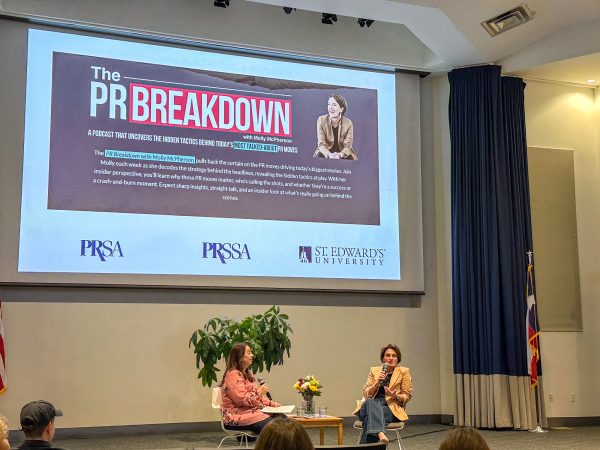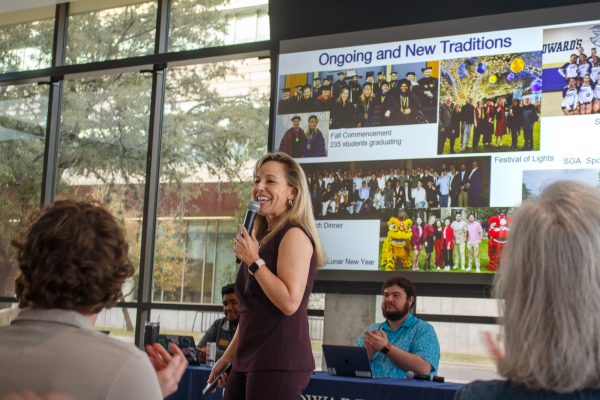11DEANP
According to the National Institute on Alcohol Abuse and Alcoholism, approximately 1,825 U.S college students aged 18 to 24 die from alcohol-related injuries. Nearly 700,000 of them are assaulted by another student who was under the influence of alcohol, and about 97,000 report sexual assault or date-rape related to alcohol consumption. Roughly one of every five college students is living with Alcohol Use Disorder (AUD), more commonly known as alcoholism.
The rest are living with the consequences of a culture that encourages reckless drinking. Hilltop Views sat down with Steven Pinkenburg, the dean of students, to better understand how to spot and support peers living with alcohol abuse
What is the difference between the kind of binge drinking that is normalized in college and alcoholism?
When somebody has gotten to a place where they’re an alcoholic, they are experiencing serious consequences, potentially catastrophic consequences, yet they continue to do the thing that is actually causing those consequences. And it very well could be that high-risk drinking when they were younger or at any point in their life has brought them to the point where they’ve actually developed the disease.
Binge drinking is definitely high-risk drinking which may lead to alcoholism. It doesn’t mean it always will, but it may lead to it. And I think, you know, there are a lot of people that will engage in high-risk drinking that will end up having consequences. It could be a DWI, it could be the loss of a relationship, it could be that academics suffer from it and then basically they’ll be able to look back and reflect on it and say, “Wow, I had some negative consequences; I need to now make some changes.” Whereas an alcoholic actually will just continue on that same path even though they’ve got these negative consequences.
A hallmark of the disease of addiction too, is denial. So a lot of times [alcoholics] are in denial that they have a problem, not really wanting to review and reflect on what all has happened. And that can be a super challenging part of the disease.
“But denial is not unhealthy. Denial becomes a problem when we stay there. And that’s probably a hallmark of addiction is that people end up staying in that same place.”
What do you mean by high-risk drinking?
“We used to tell people to practice what we call 0-1-2-3 guidelines. Basically if you’re ever driving: no drinks. If you’re going to drink everyday of your life, it’s best to have only one drink: that would be low-risk. If you’re going to drink every other day or if it’s broken up: two drinks, and never more than 3 drinks, so that you’re not getting into those high-risk practices. So if you follow those [guidelines], you’re staying away from high-risk drinking.”
“Binge drinking, and doing it often and over and over again, you are sort of beginning to work your way towards alcoholism. And it doesn’t guarantee that you’ll develop the disease.
“I think a lot of people think ‘Oh I don’t have the alcoholic gene,’ or ‘I do have the alcoholic gene so I have to be careful or ‘I have an addictive personality,’ but it’s a combination of factors. It’s not just sort of addictive personality type, there are a lot of factors to it.”
What are some of the challenges with identifying students who really need help with alcoholism versus students who just party a little too much?
“College is a time when you’re away from home for the first time. It’s a time for people to experiment; with their personality, with the way they’re dressing, with their social circles, and that goes along with drugs and alcohol too. So that’s not necessarily unusual but I think that our society sort of normalizes things. So you watch movies like Animal House and the Hangover… it’s funny, but at the same time I think it can normalize a lot of experiences. It glorifies them and it makes people go, “I want to have good stories like that.” And [in the Hangover] they didn’t have very many negative consequences in that. I mean the one guy was up on the roof and got sunburned, but they never show anybody committing suicide, they never show anybody hitting somebody head on… because that’s not funny. I think sometimes that can make it difficult to figure out who has concerns and issues that are legitimate and who’s practicing behaviors that could lead to [alcoholism].”
I will say, I am impressed with a lot of students who are coming in nowadays because I think people have better education on alcoholism and addiction. A lot of times people are coming in and self-identifying.”
What advice do you have for students who suspect their friends may be struggling with alcoholism?
I would tell those students to talk with their friend and express their concerns so the friend can actually hear what they have to say. The friend may be totally in denial and not want to hear it but at least they’ve expressed their concern, and maybe they’ve planted a seed, too.
I would also tell the students to go to the Health and Counseling Center and talk to a counselor and talk about their concerns. If it’s bad enough and they’re concerned enough with their friend’s choices I would say to get the Dean of Students office and the HCC involved. And actually it may be appropriate for us just to reach out to that student to say, “Hey, your friend has concerns for you because she cares about you and we just wanted to check in. You’re not in trouble for anything, but how can we support you?”
There are also groups like Al-Anon, which is almost like AA, but for family and friends of alcoholics and drug addicts. Those are good groups because they can help you figure out what are appropriate ways to set boundaries.
I know about it because of my background in working in addiction. We say that addiction is a family disease. You have the IP, or the identified patient who is doing the drinking. But their drinking affects the entire family system. The IP needs help, but so does the whole family, and they don’t get that at first. But the drinking and the use has affected the family so much they need help again figuring out boundaries, making sure they’re not enabling, and actually dealing with the consequences of having a family member that has not shown them love or has taken advantage of them.






